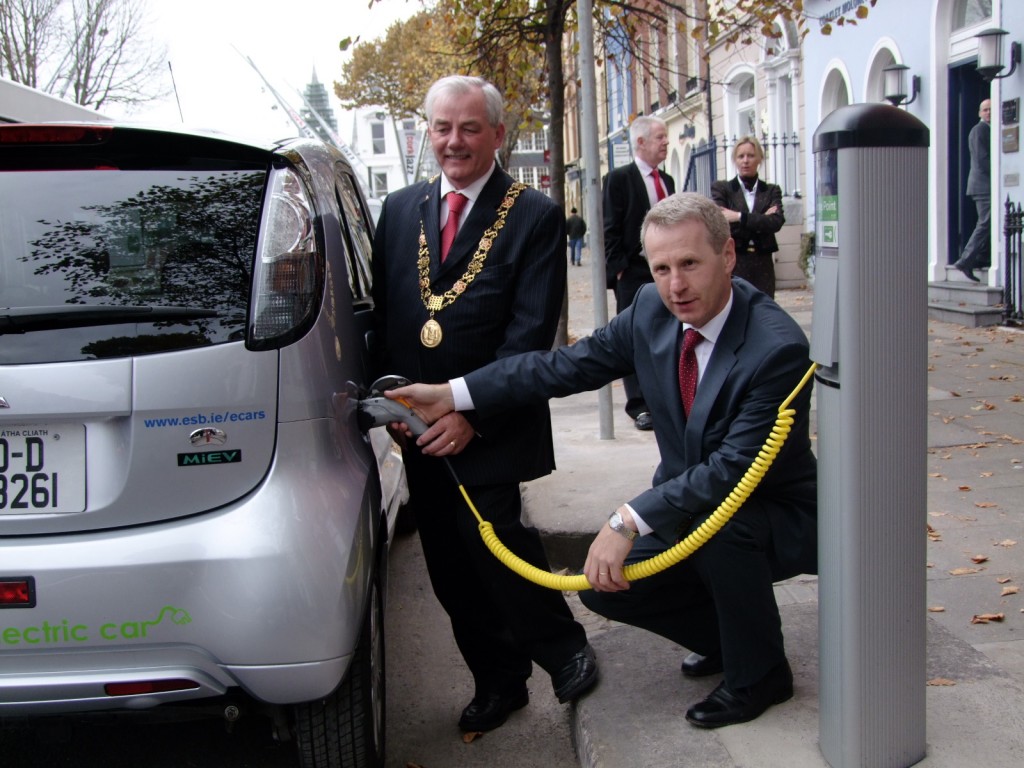On last Monday morning (19 Oct), I had the pleasure of seeing the role out of the third ecar charging post in Cork City. It is on the South Mall. In an age of no money being around, one can be cynical and question how this project is to be rolled out. However, I was quite taken by the science of the whole project and the reasons behind such a roll-out. Great to see new ideas being investigated and built upon in reality. Below is some material sourced from www.esb.ie
What is an Ecar?
An ecar has an electric motor and can be summarised into one of two broad categories:
- A pure electric car has a battery that is charged by connecting to the electricity supply network. It has a range of 160km.
- A plug-in hybrid has a battery that works in tandem with an internal combustion engine. The range is extended because when the battery runs out the combustion engine takes over.
There are a wide range of ecars available and car manufacturers plan to commence mass production in the coming months. To cater for everyone’s taste, there is something to suit everybody, ranging from a compact city car or a family saloon to a sleek, racy, sports car. View a selection of cars opposite.
Charging Methods:
Home charging – Ecars will be charged overnight from their normal domestic electricity supply, taking approximately 6-8 hours.
Destination charging – Charging posts will be available in a wide variety of convenient public places such as on-street, car parks and shopping centres. A full charge will take approximately 1 to 1.5 hours.
Fast charging – Fast charging posts will be available to charge an ecars in 20-25 minutes. These will be located in petrol stations or roadside cafes.

Benefits:Environmentally friendly – The transport sector is responsible for a large percentage of carbon emissions. Ecars offer a real opportunity to reduce the carbon output of the transport sector, emitting zero tailpipe CO2 emissions. The growth in the generation of electricity from renewable sources in the future offers a route towards carbon free motoring.
Other advantages include an improvement in air quality and reduction in noise pollution.
More efficient and economical driving – The electric motor in an ecars is much more efficient than a combustion engine. This means that the running costs are significantly lower. Running costs of an ecar is typically in the order of 2 to 3 cent per km and compared to 12 cent per km for an equivalent petrol vehicle, this represents a huge saving in fuel consumption.
More efficient energy usage – It is envisaged that the majority of charging will be carried out overnight when the demand for electricity is off peak. Electricity suppliers will promote off peak times to consumers and ensure demand and capacity is balanced.
In the future vehicle batteries will be able to store energy at times of low demand and then feed this back to the grid at peak times. This is known as vehicle to grid (V2G) and will further support the development of renewables as a steady source of energy.
Enterprise opportunities – Any new market offers opportunities for the development of new products, technologies and services. The ecars market is no different with a variety of new charging post companies emerging, battery technology developments as well as new software and infrastructure products.
Financial incentives!:
The government fully supports the introduction of ecars. There has been a number of incentives introduced by the Government to stimulate demand, they include:
- VRT exemption for ecars up to year 2012
- VRT relief scheme for plug-in hybrids
Car manufacturers will also incentivise the consumer with special schemes and attractive introductory offers.
http://www.esb.ie/main/sustainability/ESB-ecars-animation.jsp




